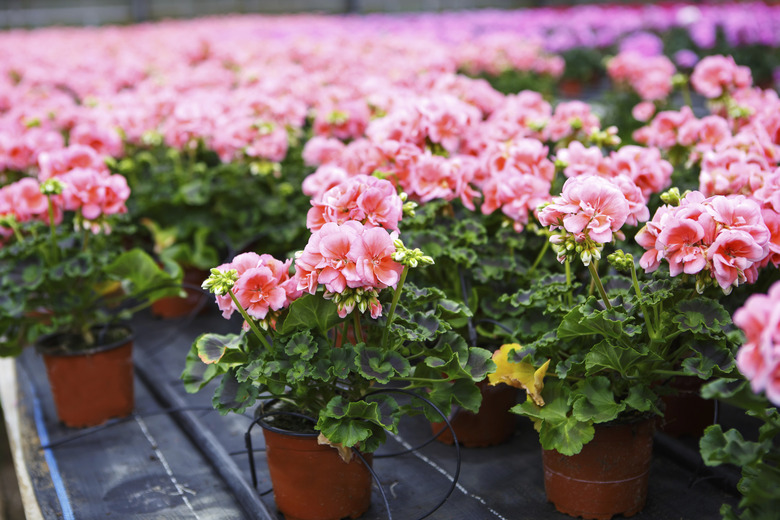The Causes Of Yellow Leaves On Geraniums
Zonal geraniums (Pelargonium x hortorum) in containers, Martha Washington geraniums (Pelargonium x domesticum) on window sills, ivy geraniums (Pelargonium peltatum) in baskets or scented geraniums (Pelargonium ssp.) along a garden walk — all provide long seasons of bright, colorful blooms backed by thick, green foliage almost as distinctive as their flowers. Yellowing leaves can be caused by environmental, health or nutritional factors.
Coming Indoors
Geraniums are hardy only in U.S. Department of Agriculture plant hardiness zones 10 through 11, so most are grown as annuals. The first garden geraniums were natives of southern Africa, so the plants love sun and dry weather, making them natural choices for warm summer color. Their native environment provides two clues to yellow leaves — not enough light and too much water — both common when plants are brought indoors to overwinter.
Leaves may also yellow when plants are brought indoors *after a sudden cold snap — bring plants in before your central heating fires up for the first time to minimize shock. Find the brightest south or west window for overwintered geraniums and allow them to go almost dry before watering. When watering geraniums, water until it runs out the hole in the bottom of the pot, and never allow the plants to stand in water.
Eschew Extremes
If you're fortunate enough to live in a frost-free area, you can grow geraniums outdoors until they reach the size of shrubs. Garden geraniums are more genteel than their rugged South African predecessors, though. They need light and heat, but there is a limit, and you'll know you've reached it when leaves start to yellow on summer days **when nighttime temperatures stay above 72 degrees Fahrenheit.**
Geraniums perform best in daytime temperatures from 70 to 85 degrees Fahrenheit and nighttime temperatures from 55 to 65 degrees. Combat yellowing when temperatures stay hot by shading plants during the hottest part of the afternoon, and mulch soil surfaces with 1 to 2 inches of shredded bark. Water them in the morning to fortify them for the day ahead. Water stress can also cause leaf yellowing — beginning in lower leaves.
Bad Actors
Several bacterial "wilts" can cause leaf yellowing. Ralstonia solanacearum begins with yellowing along leaf edges or with **V-shaped wedges.** Xanthomonas' dark leaf spots are surrounded by yellow. Botrytis fungus appears as V-shaped yellowing during humid weather. Pythium root rot can also cause yellowing. By the time yellowing occurs, wilts and pythium root rot have doomed the plant. Cutting botrytis-afflicted pants to the ground may save the plant if there are no cankers on the stem.
Need to Feed
Geraniums' bold displays require plenty of nutrients. Nitrogen-deficient plants will slow growth and flowering, but yellow leaves give you a clue that your plants need more food than is available. Give geraniums 14-14-14 or 20-20-20 garden food weekly while they are actively growing to provide **major nutrients of nitrogen, phosphorus and potassium.** Mix soluble food at full strength, typically a tablespoon per gallon of water.
Ivy geranium leaves may yellow due to **heat or iron deficiency.** Give them a soluble food containing iron chelate or iron sulfate. If using time-release types, rush the timing — if a feeding is good for six months, reapply in four months.
References
- Missouri Botanical Garden: Pelargonium X Hortorum
- Missouri Botanical Garden: Pelargonium X Domesticum
- Missouri Botanical Garden: Pelargonium Peltatum
- Missouri Botanical Garden: Pelargonium (Scented-Leaved Group)
- Milmont Greenhouses: Geranium Care for the Consumer
- North Dakota State University Extension Service: Questions on: Geranium
